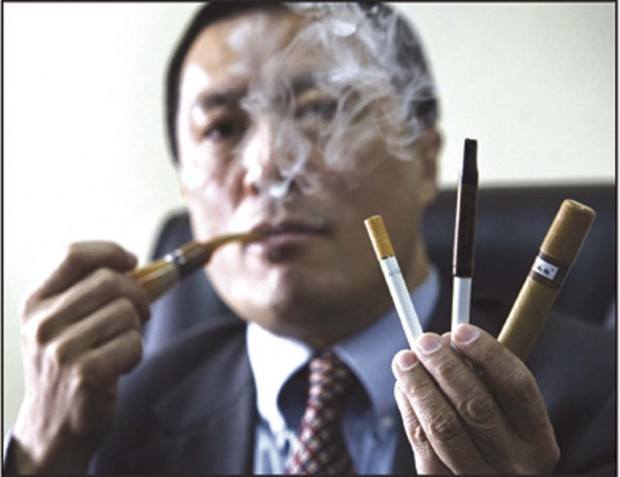LIHU‘E — Chinese company Ruyan Group, now Dragonite International, patented electronic cigarettes in 2004. Users click a button and a puff of vaporized nicotine is released. At the same time an orange or blue tip lights up, simulating the end
LIHU‘E — Chinese company Ruyan Group, now Dragonite International, patented electronic cigarettes in 2004.
Users click a button and a puff of vaporized nicotine is released.
At the same time an orange or blue tip lights up, simulating the end of a lit cigarette.
E-cigarettes have been available in the United States for a while. Kaua‘i residents only had access to them through the Internet. But about two years ago Kehau Duran started selling them. In March she finally opened a shop, located on Rice Street in Lihu‘e, behind City Liquor.
“Over the past two years I’ve seen so many people quit smoking, but that’s not what it’s for,” Duran said.
One of Duran’s employees, however, used it, and said she doesn’t smoke either traditional or e-cigarettes anymore, and after only a couple of months using it.
The employee, Trisha Mae Flores, said she started using e-cigarettes with high nicotine content. After a while she stepped down to medium nicotine content, then to light. Finally she started using e-cigarettes without any nicotine in them.
Now Mae Flores says she doesn’t even use the nicotine-free set anymore.
She said she gave it to her mother, who now doesn’t smoke traditional cigarettes anymore, but still uses the e-cigarettes.
Duran said many of her customers successfully used the e-cigarettes to quit smoking. Others, she said, just do it to satisfy the habitual fix.
“You can’t smoke 20 feet from anywhere, and now you don’t have to,” said Duran, adding that it’s legal to use e-cigarettes in most places where smoking is prohibited.
Some people may be concerned that it contains nicotine, but Duran pointed out that popular devices to help quit smoking such as skin patches and gums also contain nicotine.
Concerns
Despite all the apparent benefits, the growing popularity and all the Internet discussion of e-cigarettes, some health officials are not convinced about the safety of e-cigarettes.
An opinion released Nov. 2 in the journal Annals of Internal Medicine highlights potential dangers of e-cigarettes, and suggests they may not be as safe as retailers claim.
The opinion says that studies have shown mixed findings.
Some studies reported that less nicotine is absorbed, curtailing the desire to smoke. Other studies, however, showed that smoking cravings weren’t affected as much.
A laboratory analysis of e-cigarettes conducted in 2009 by the U.S. Food and Drug Administration found “trace amounts of the harmful solvent diethylene glycol, the presence of nicotine in a light e-cigarette labeled as nicotine-free, and a two-fold variation in nicotine released by each puff,” according to the journal.
The e-cigarettes are made of three parts: A plastic tube, an electronic heating element, and a liquid nicotine cartridge.
Duran said the liquid nicotine is made of five ingredients: Water, propylene glycol, food coloring, flavoring and nicotine.
Users can choose from an array of fruit flavors. But they can also have the traditional cigarette or menthol flavor.
The authors of the paper published in the journal say the e-cigarette boom presents public-health concerns on at least three fronts.
First, the paper says that e-cigarettes may pose as starter products for non-tobacco users. The posturing of e-cigarettes as green and healthy could deceptively lure teens. E-cigarettes may represent a way to skirt smoke-free, indoor-air laws.
E-cigarette marketing claims that it can be used indoors almost everywhere smoking is banned.
Second, the paper says that potential e-cigarette toxicities exist and that are not well-quantified.
Flores said one refill bottle is equivalent to as much as two cigarette cartons.
The nicotine dose that could be ingested, or even absorbed through the skin, could induce a fatal overdose in children, according to the paper, which also questioned the safety of the e-cigarette’s second-hand vapor.
Third, the report says there’s little research determining whether e-cigarettes have potential as smoking-cessation devices.
Duran said that as far as she knows, there are over 4,000 different chemicals in a traditional cigarette. She said she would rather use e-cigarettes, in which she says the only harmful ingredient is nicotine, over traditional cigarettes anytime.
The paper says health professionals need to monitor biological, social and addictive effects of e-cigarettes and be aware of their rapid dissemination.
“Although the safety and efficacy of e-cigarettes is uncertain, we believe that clearly counseling patients against e-cigarettes use, as well as other tobacco use, is prudent,” said the paper.
Duran, on the other hand, has a list of customers who quit being her customers simply because they quit smoking altogether.
• Léo Azambuja, staff writer, can be reached at 245-3681 (ext. 252) or lazambuja@kauaipubco.com.




